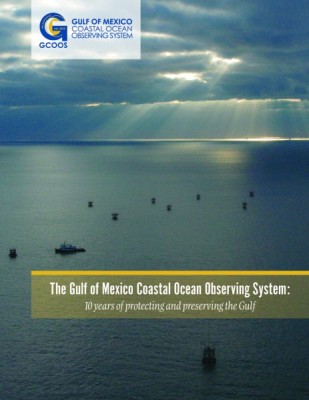Sep 30 2015
A new report from the Gulf of Mexico Coastal Ocean Observing System Regional Association (GCOOS-RA) details the first 10 years of the nonprofit organization's work to improve access to ocean observing data that helps to protect and preserve the Gulf and its residents.
 The Gulf of Mexico Coastal Ocean Observing System: 10 Years of Protecting and Preserving the Gulf
The Gulf of Mexico Coastal Ocean Observing System: 10 Years of Protecting and Preserving the Gulf
The report, "The Gulf of Mexico Coastal Ocean Observing System: 10 Years of Protecting and Preserving the Gulf," was published in recognition of the organization's 10th anniversary and released at its September board meeting in St. Petersburg, Fla. The report outlines improvements made in:
—Developing early warning systems for harmful algal blooms;
—Integrating data that supports improved weather and hurricane forecasts;
—Safer navigation in the Gulf's ports;
—Educating residents on the important role the Gulf plays in their daily lives.
[Read the full report]
At the heart of these improvements is the GCOOS-RA. As a member of the U.S. Integrated Ocean Observing System, GCOOS-RA is responsible for bringing together representatives from the maritime industry, governmental and nongovernmental organizations, marine scientists and resource managers to combine ocean data to provide timely information about the Gulf of Mexico. The data comes from instruments mounted on things such as buoys, autonomous underwater vehicles and even oil platforms.
"Probably the most notable success in our first 10 years is the fundamental change that we've made in how ocean monitoring is conducted in the Gulf," said Dr. Barbara Kirkpatrick, Executive Director of the GCOOS-RA. "GCOOS has helped move organizations away from collecting and keeping their own ocean data to sharing and exchanging information in real-time and near real-time. We helped to develop data management standards and we provide a portal where organizations can stream their data and provide public access."
Integrating real-time and near-real-time data streams collected from many scientific partners throughout the Gulf of Mexico and providing it in a single, easy-to-navigate website is at the heart of the GCOOS-RA mission. But since its beginning days in 2005, GCOOS organizers knew that was only one piece of developing a robust and interactive coastal ocean observing system. Equally important? Providing information to the public in a way that was useful for end users in all sectors -- from government, to industry to environmental educators and the general public.
That led to the creation of the GCOOS Outreach and Education Council, which educates user communities and residents about GCOOS products to increase overall ocean literacy and also informs developers about the types of products needed by different end users, such as recreational boaters or ship captains.
"It was really visionary of the early organizers of GCOOS to focus on data integration along with education and outreach," said David Driver, Chairman of the GCOOS Board of Directors. "That has given GCOOS the ability to support experts throughout the Gulf in the development of new ocean observing tools, in maintaining observing instrumentation and in making sure that the ocean community is aware of the tools available to help them in their day-to-day operations."
Today, the GCOOS-RA has 132 members and 16 data providers and has developed a comprehensive plan that addresses the need to maintain and enhance existing Gulf observation tools, bring new measurements online and to fill the largest data gaps. Among other improvements, this GCOOS-RA Build Out Plan calls for expanding high-frequency radar (HFR) and autonomous underwater vehicle observations in the Gulf.
HFR is a system of transmitters and radio antenna receivers along coastlines or on oil platforms; they transmit radio signals that are relayed to the receivers after bouncing off the ocean's surface. The signals received are related to the speed and direction the currents are moving and by wave heights. Because the information comes in near-real time, it is vital for developing accurate, timely forecast models that are especially crucial during response efforts when lives, habitat and property are at risk from hurricanes and oil spills.
Autonomous underwater vehicles (AUVs), also known as gliders, are torpedo shaped, untethered instruments that use buoyancy to move up and down in the water column in a zig-zag pattern, taking in water to move down and expelling water to move up. They are equipped with radio and satellite transmitters that transmit data gathered on things like water temperature, salinity, water currents and other conditions that can reveal water quality and the effects of storms back to researchers in a laboratory.
Gliders can be outfitted with various types of instruments to detect things like harmful algal blooms and oil or other contaminants. Sensors on these platforms were tremendously valuable in locating oil below the surface during the DWH spill and in subsequent tracking of its movement following the explosion.
"The Deepwater Horizon explosion illustrated the need for support to maintain and enhance our observing capabilities in the Gulf," Kirkpatrick said. "The Gulf remains one of the world's most important and productive bodies of water and we need assets in place to protect it."